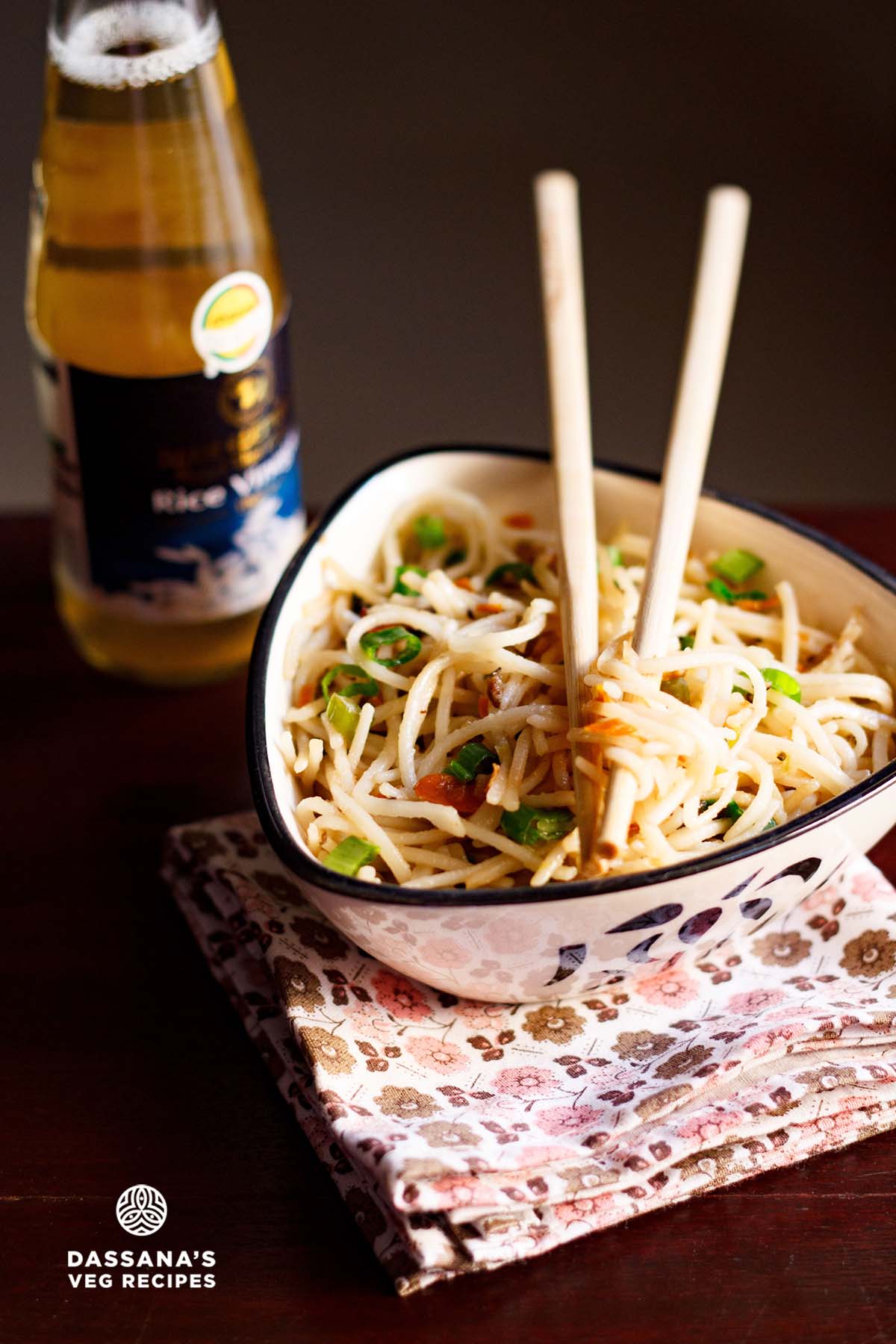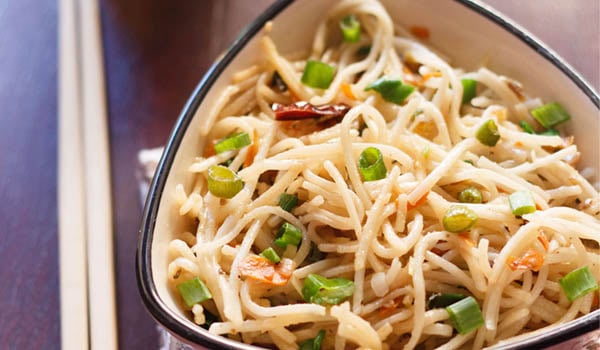Hakka Noodles refers to both a unique type of dried noodle and the delicious dish prepared with it. Made primarily from plain flour, Hakka Noodles are cooked until al dente and then tossed with stir-fried vegetables seasoned with soy sauce, spices, and salt. This dish is a staple on the menus of restaurants serving Asian, Oriental, and Indo-Chinese cuisines across India, and it is also a popular choice at street-side Chinese eateries throughout the Indian subcontinent.

About Hakka Noodles
Hakka Noodles is a beloved Indo-Chinese stir-fried noodle dish commonly found in various restaurants and street-side Chinese food stalls in India.
The origins of Hakka Noodles date back to the arrival of Chinese migrants in Kolkata, West Bengal, who created a fusion dish by combining Chinese noodles with local Indian spices, vegetables, and herbs.
To prepare this stir-fried noodle dish, a specific type of noodle known as Hakka Noodles is used. These noodles are made from white flour (maida) and water, typically without eggs, resulting in a medium-thickness noodle that can withstand high heat without becoming soft.
Hakka Noodles are easily available in India, and those living abroad can find them in Asian or Indian grocery stores or online.
The recipe shared here is straightforward, making it accessible for anyone to recreate this delicious dish at home.
About The Recipe
To make Hakka Noodles, you’ll need dried Hakka Noodles, assorted vegetables, and typical Chinese sauces such as soy sauce. A neutral oil like sunflower or sesame oil works well for cooking.
This vegetarian and vegan-friendly recipe is packed with vegetables and mushrooms, making it not only delicious but also appealing to both kids and adults. It’s sure to leave you wanting more!
Hakka Noodles pair wonderfully with popular Indo-Chinese dishes like Chilli Paneer, Chilli Mushroom, or any Manchurian gravies.
Use of Celery
In many of my Indian-Chinese fusion recipes, I incorporate celery. Many readers ask about where to find celery in India. It is a herb that is commonly available in supermarkets in metropolitan areas. While it’s optional for this Hakka Noodles recipe, I recommend using it if you can source it.
You can also grow celery at home in a pot. Simply buy a plant from a nursery or plant the seeds. Alternatively, you can chop celery and plant its base in soil.
Ingredient Essentials
Here’s a handy list of ingredients to help you perfect the Hakka Noodles recipe at home:
- Hakka Noodles: Any Indian brand will work well. I recommend Ching’s. If you’re looking for a healthier option, consider whole wheat or soba noodles. If Hakka noodles aren’t available, you can substitute with Chow Mein noodles, ramen, or even spaghetti.
- Vegetables: Feel free to add your favorite vegetables. Mushrooms (button or cremini) add a meaty texture and umami flavor. Other options include cabbage (green or purple), carrots, French beans, zucchini, broccoli, capsicum, and spring onions.
- Toasted Sesame Oil: This oil imparts a lovely smokiness to the noodles. If unavailable, any neutral oil like sunflower or avocado oil will suffice.
- Herbs & Spices: Garlic, dried red chilies (or green chilies), celery, or fresh coriander leaves are great additions. If celery is hard to find, feel free to omit it.
- Soy Sauce: Opt for naturally fermented soy sauce for a rich umami flavor. Alternatives include Bragg liquid aminos or tamari.
- Rice Vinegar: You can use white vinegar, apple cider vinegar, rice wine, or mirin as substitutes. Rice vinegar adds a distinct flavor to the dish.
How to Make Hakka Noodles
Prep Veggies & Cook Noodles
- Finely chop all the vegetables and set them aside. You can also shred or grate them using a food processor.
- Boil 4.5 cups of water in a pot with ½ teaspoon of salt and a few drops of oil.
- Once the water is boiling, add 200 grams of Hakka noodles. Stir with a fork and cook according to package instructions until al dente.
- Drain the cooked noodles in a colander and rinse them with fresh water to stop the cooking process and remove excess starch.
- Add 1.5 teaspoons of toasted sesame oil to the noodles and toss well to coat evenly.
Stir Fry Ingredients
- Heat 2 tablespoons of sunflower oil (or any neutral oil) in a frying pan or wok.
- Sauté 2 to 3 dried red chilies (broken and seeds removed) and 1.5 teaspoons of finely chopped garlic on medium-low to medium heat for about a minute.
- Increase the heat and add 3 to 4 finely chopped spring onions and 8 to 10 finely chopped French beans. Stir-fry for about 3 minutes.
- Add 4 to 5 finely chopped button mushrooms, 1 small to medium finely chopped carrot, and 1 teaspoon of finely chopped celery. Continue stir-frying.
- Stir-fry for about 5 to 6 minutes or until the vegetables start to brown slightly at the edges.
- Add 1.5 teaspoons of soy sauce and mix well.
Make Hakka Noodles
- Add the cooked noodles to the pan and toss to mix. Stir-fry for 1 to 2 minutes.
- Season with salt and crushed black pepper to taste. Add ¼ teaspoon of rice vinegar, white vinegar, or rice wine.
- Toss well and stir-fry again for a minute.
- Turn off the heat, add 1 to 2 tablespoons of chopped spring onion greens, and mix well. Alternatively, garnish with spring onions while serving.
- Serve Hakka Noodles hot, either on their own or alongside Indo-Chinese dishes like Gobi Manchurian, Paneer Manchurian, or Chilli Mushroom.
Expert Tips
- Cooking Noodles: Boil noodles until al dente, as they will cook further during stir-frying. Avoid overcooking to prevent a mushy texture.
- For Non-Sticky Noodles: Rinse cooked noodles well and toss with oil to eliminate stickiness.
- Chopping Veggies: Ensure vegetables are finely chopped for quick and even cooking.
- Frying Pan or Wok: Use a wok or frying pan with handles for easy tossing. Cast iron or carbon steel pans are ideal for high-heat stir-frying.
- Stir Frying: High heat is key for achieving that smoky flavor and retaining crunch in vegetables. Use medium to medium-high heat for home cooking.
- Authentic Flavors: Incorporate toasted sesame oil, celery, and rice vinegar for an authentic taste.
- Gluten-Free Options: Use gluten-free noodles and tamari or Bragg liquid aminos for a gluten-free version.





